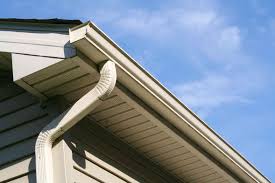Imagine a team of elite professionals assigned to protect your home. On this team, the roof gets all the attention—it’s the captain, the star, the one standing tall against the elements. The shingles shine under the sun, the flashing looks sharp in the corners, and the underlayment is the silent workhorse doing its job without fuss.
But down at the edge of the field—humble, quiet, often overlooked—are the gutters.
They’re not flashy. They’re not glamorous. But without them, the whole team fails.
Gravity Never Takes a Break
Every time it rains, gravity goes to work. It pulls every drop of water down, trying to route it into the easiest path. On a roof, that means toward edges, valleys, low slopes, and eventually—if nothing stops it—into places you don’t want it: walls, foundations, basements.
That’s where gutters come in. They don’t fight gravity—they work with it. They collect the flow, direct it, and release it in ways that protect everything beneath them.
Yet most homeowners don’t think about gutters until something goes wrong. A clog. An overflow. A stain on the siding. By then, water has already done what it does best—find the cracks.
Roofs and Gutters: A System, Not Separate Parts
When people talk about roof replacements, the conversation usually revolves around shingle type, underlayment options, ridge vents, and warranties. Gutters rarely make the list.
But they should.
Why? Because your roof doesn’t work in isolation. It’s a dynamic system of surfaces, slopes, and edges designed to channel water away from your home. And that system fails if the final handoff—your gutters—is broken, undersized, or poorly placed.
Water that isn’t guided away will back up, seep under shingles, rot fascia boards, and even sneak inside walls.
That’s why every roofing conversation should include a gutter check. Are they large enough? Are the downspouts clear? Is the pitch right? Do they direct water far enough from the foundation?
These questions aren’t extras—they’re essential.
The Problem with “Good Enough” Gutters
Not all gutters are built the same. Many homes still rely on basic systems installed decades ago—too narrow for today’s weather patterns, poorly angled, or loosely fastened.
Additions, second stories, and new construction roofs often put extra strain on existing gutter systems. Rooflines grow more complex, drainage patterns shift, and what worked for the original structure may now be overloaded.
Water doesn’t care if your gutters are “good enough.” It cares whether it can flow, uninterrupted, through the system and away from your home.
If it can’t, it will find another path. Usually one you don’t want.
The Freeze-and-Thaw Factor
In colder climates, improperly draining gutters invite a silent threat: ice.
When water backs up and freezes at the edge of a roof, it forms what’s known as an ice dam. Behind the dam, meltwater pools and can seep under shingles—damaging not just the roof, but insulation, drywall, and framing.
While many think of ice dams as roofing issues, they often begin with ineffective gutters.
Well-maintained, correctly pitched gutters help prevent freeze buildup. They empty fast. They stay clear. And they allow water to flow away before temperatures drop.
Small Failures, Big Repairs
Let’s say a downspout is partially blocked. Just one. During a heavy storm, water can’t exit fast enough, and it spills over the gutter edge. Over time, that steady overflow can:
- Saturate the soil around your home’s foundation
- Crack sidewalks or patios
- Cause erosion in landscaped areas
- Leave stubborn stains on siding or brick
And on the roofline, those same overflows can slowly rot wood, rust nails, and degrade your fascia.
What began as a minor blockage becomes a major repair bill—sometimes even leading to roof repairs that could’ve been avoided with better water management.
Roof Additions and Gutter Modifications
Adding a sunroom, garage, or upper-level bump-out? That means more roof—and more water.
Addition roofs often change the way water travels across your home. Valleys may be introduced, slopes may vary, and water may now channel into areas never designed to receive it.
That means your gutters must evolve too.
Too often, the main roof’s system is left untouched while new sections get their own gutters—without considering how the two interact. Water gets caught in transition zones, backups form, and overflows occur at the seams.
That’s why it’s vital to assess gutter systems every time a new roof element is added, whether it’s a structural change or a full roof replacement.
When It’s Time to Upgrade
Not sure if your gutters are up to the task? Here are signs it might be time for an update:
- Water spills over edges even when it’s not raining hard
- Downspouts regularly clog
- Gutters pull away from the fascia
- Visible rust or sagging
- Mold or mildew around foundation edges
- Erosion lines or water stains beneath rooflines
Upgrading may mean wider channels, better anchors, or additional downspouts. In some cases, rerouting flow can make a significant difference—especially for homes with landscaping features or elevation changes near the foundation.
A quick inspection from a trusted local provider Mike Ragan Roofing can reveal more than a visual check alone.
Don’t Forget the Exit Strategy
Getting water off the roof is only half the job. Getting it away from the house is the rest.
Even well-designed gutters fail if downspouts discharge water right next to the foundation. Splash blocks, buried drain lines, or extensions are often needed to complete the system.
Think of it this way: your gutters collect and move water, but the final destination determines whether your home stays dry.
A full drainage system may not be exciting—but it’s the quiet reason your roof stays strong, your basement stays dry, and your siding doesn’t peel.
Conclusion: The Unsung Hero at the Edge of Your Roof
Gutters aren’t just accessories. They’re essential components of your roofing ecosystem. They take the weight of every storm and carry it away before damage begins.
While roofs get the glory, gutters carry the burden. And smart homeowners know that ignoring them is never worth the risk.
So next time you look up and admire the lines of your shingles or the angle of your new addition roof, take a moment to look lower. Because that simple channel running along the edge? It’s doing more to protect your home than you realize.






